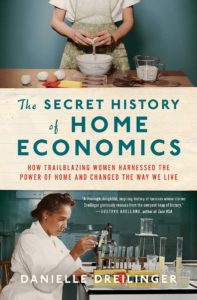Book Review: The Secret History of Home Economics
Nonfiction BookTube and bloggers worldwide are participating in the History Challenge 2021 from August 16 – 31. Participants are being asked to read at least one nonfiction history book during this period. Historical fiction books are also acceptable. It’s a great way to challenge your reading habits and learn something new!
Here are some optional prompts to help you choose your book:
- Read a biography, memoir, or autobiography
- Read a book that takes place on a different continent
- Read a book about a school topic you studied
- Read a book by a BIPOC author
- Read about a favorite time period
- Read a book by a woman author
- Read a book about your favorite leisure or hobby
- Read a microhistory book
- Read about a social movement
- Read a book in translation
 If you have been following this blog long enough, it’s not hard for me to read a history book! I choose The Secret History of Home Economics: How Trailblazing Women Harnessed the Power of Home and Changed the Way We Live by Danielle Dreilinger. The author is a former WGBH and Boston Globe reporter who now lives in New Orleans, an education reporter for the Times-Picayune. This is a fascinating read about a field that has made major contributions to bettering society. I didn’t know a lot of things before reading the book, such as Ellen Swallow Richards, the first woman to attend MIT, laid the groundwork for home economics by introducing how science can improve the home, specifically around sanitation and nutrition. Historically Black Colleges and Universities (HBCUs) also played a role in the field’s development. Margeret Murray Washington, the third wife of Booker T. Washington, saw home economics as a way to uplift Black communities.
If you have been following this blog long enough, it’s not hard for me to read a history book! I choose The Secret History of Home Economics: How Trailblazing Women Harnessed the Power of Home and Changed the Way We Live by Danielle Dreilinger. The author is a former WGBH and Boston Globe reporter who now lives in New Orleans, an education reporter for the Times-Picayune. This is a fascinating read about a field that has made major contributions to bettering society. I didn’t know a lot of things before reading the book, such as Ellen Swallow Richards, the first woman to attend MIT, laid the groundwork for home economics by introducing how science can improve the home, specifically around sanitation and nutrition. Historically Black Colleges and Universities (HBCUs) also played a role in the field’s development. Margeret Murray Washington, the third wife of Booker T. Washington, saw home economics as a way to uplift Black communities.
I also appreciated the author’s frankness about the racism that was pervasive in the field. The American Home Economics Association, found in 1908, only became racially integrated in the mid-1970s. Despite the racism, many home economists of color persisted, like Fabiola Cabeza de Baca, a Latina nutritionist who taught homemaking to indigenous communities in New Mexico and advocated for Hispanic civil rights. She is my personal hero because she invented the fried U-shaped taco! Flemmie Kittrell was the first African-American woman to earn a Ph.D. in nutrition, who was instrumental in her research for improving nutrition for Black children and families in developing countries. I also didn’t know that home economics played a key role in developing the national school lunch program, the Head Start program, and space food for astronauts. Did you know that the idea for the Amazon Echo was originally developed by a home economist back in the 1960s?
So what happened to home economics? Up until the 1970s, most US K-12 schools and colleges and universities offered home economics programs. Unfortunately, the field fell victim to its own hype. These programs were specifically designed for women and told them that they didn’t need careers if they were homemakers. Eventually, women realized they didn’t need to go to college since they weren’t pursuing careers. Home economics also suffered from the backlash of the civil rights and women’s liberation movements of the 1960s, where women of all races were embarrassed to say that they studied the field publicly. Because of all this, home economics is not really taught in many American schools anymore.
By the 1980s and 1990s, home economics programs were being phased out of schools. I remember taking a home economics class in elementary school. The only thing I learned was how to bake chocolate chip cookies by safely using the oven and cleaning pans and utensils. Looking back at that time, I wish schools would invest more in home economics. Now more than ever, we need home economics. This pandemic has forced all of us to be at home more and think about our everyday routines.
The author makes a lot of great suggestions to bring back home economics, like making it mandatory for both boys and girls to learn it in schools, embracing these life skills on the same level as career preparation, include more STEM perspectives in home economics, and diversify the profession with more people of color and men.
This is definitely a great read!
